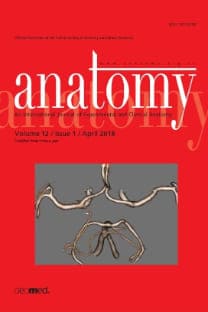Improving the efficacy of cadaveric demonstrations for undergraduate anatomy education
Improving the efficacy of cadaveric demonstrations for undergraduate anatomy education
___
- 1. Selcuk I, Tatar I, Huri E. Cadaveric anatomy and dissection in surgical training. Turk J Obstet Gynecol 2019;16:72–5.
- 2. Dissabandara LO, Nirthanan SN, Khoo TK, Tedman R. Role of cadaveric dissections in modern medical curricula: a study on student perceptions. Anat Cell Biol 2015;48:205–12.
- 3. Estai M, Bunt S. Best teaching practices in anatomy education: a critical review. Ann Anat 2016;208:151–7.
- 4. Sugand K, Abrahams P, Khurana A. The anatomy of anatomy: a review for its modernization. Anat Sci Educ 2010;3:83–93.
- 5. Winkelmann A. Anatomical dissection as a teaching method in medical school: a review of the evidence. Med Educ 2007;41:15–22.
- 6. Azer SA, Eizenberg N. Do we need dissection in an integrated problem-based learning medical course? Perceptions of first- and secondyear students. Surg Radiol Anat 2007;29:173–80.
- 7. Cottam WW. Adequacy of medical school gross anatomy education as perceived by certain postgraduate residency programs and anatomy course directors. Clin Anat 1999;12:55–65.
- 8. Selçuk ‹, Barut Ç, Çal›flkan E. Impact of a gynecologic oncology cadaveric dissection course for surgical training. Anatomy 2019;13: 56–60.
- 9. Smith CF, Finn GM, Stewart J, Atkinson MA, Davies DC, Dyball R, Morris J, Ockleford C, Parkin I, Standring S, Whiten S, Wilton J, McHanwell S. The Anatomical Society core regional anatomy syllabus for undergraduate medicine. J Anat 2016;228:15–23.
- 10. Jeyakumar A, Dissanayake B, Dissabandara L. Dissection in the modern medical curriculum: an exploration into student perception and adaptions for the future. Anat Sci Educ 2019; doi: 10.1002/ ase.1905 [Epub ahead of print]
- 11. Aziz MA, McKenzie JC, Wilson JS, Cowie RJ, Ayeni SA, Dunn BK. The human cadaver in the age of biomedical informatics. Anat Rec 2002;269:20–32.
- 12. Pais D, Casal D, Mascarenhas-Lemos L, Barata P, Moxham BJ, Goyri-O’Neill J. Outcomes and satisfaction of two optional cadaveric dissection courses: a 3-year prospective study. Anat Sci Educ 2017; 10:127–36.
- 13. Stringer MD, Nicholson HD. Modern approaches to teaching and learning anatomy: modern models are already being applied. BMJ 2008;337:a1966.
- ISSN: 1307-8798
- Yayın Aralığı: 3
- Başlangıç: 2007
- Yayıncı: Deomed Publishing
İlker SELÇUK, Mehmet ÜLKİR, Caner KÖSE, Burak ERSAK, Yağmur ZENGİN, İlkan TATAR, Deniz DEMİRYÜREK
Marwa Abd EL KADER, Hagar A. HASHİSH
Macroscopic footprint of the glenoid labrum
Mehmet Emin ŞİMŞEK, Özgür KAYA, Nihal APAYDIN, Safa GÜRSOY, Murat BOZKURT, Mustafa AKKAYA
Saliha ADANIR, İlhan BAHŞİ, Mustafa ORHAN, Piraye KERVANCIOĞLU, Ömer CİHAN
Müge KARAKAYALI, Tuna ÖNAL, İbrahim TUĞLU
Sunil SHRESTHA, Rojina SHAKYA, Dil MANSOOR, Dilip MEHTA, Shamsher SHRESTHA
‹smail MALKOÇ, Cengiz ÖZTÜRK, Mehmet Nuri KOÇAK, Tuba DEMİRCİ, Mehmet Dumlu AYDIN
